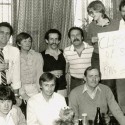Reporter PHIL MCLEOD wrote for the Journal for 20 years. He covered footballer Darren Millane’s funeral, conducted one of the last interviews with author Frank Hardy and helped broker a truce between two warring street gangs so they could be interviewed.
THE (Oxford) dictionary defines the word journal as a record of news and events of a personal nature.
For 150 years The Dandenong Journal has had a ‘personal’ relationship with the city and its residents through depression, war, generational conflicts, life and death.
The differing style of its mastheads has reflected the city’s change from a grazing township and its reputation as the Gateway to Gippsland, to an industrial and commercial hub known and becoming known as Melbourne’s second city, through to today’s vibrant multicultural community in the City of Opportunity.
Dandenong has endured many challenges that have tested the character and fibre of its people.
It was named as a heroin hot spot by the then State Government, and the resultant crime made it dangerous for people to walk the streets. They lived in fear. It was personal.
The Journal launched a community war on drugs campaign and unashamedly hounded the government for more police and recourses to win back the streets. The paper then asked its readers to dob in a dealer to police to rid the community of the purveyors of death and the destruction of people’s lives. It was personal.
The paper and the community stood as one in fighting the heroin epidemic, and are making a similar stand today in their all-out assault on the insidious drug, ice.
The city also had to endure the emergence of a new criminal threat, American-style street gangs.
The most notorious was 3174 (Noble Park’s postcode) who gained media-wide attention after several raids, or in gang terms, steaming, on several shopping centres.
Steaming involved gang members descending on a store en masse and while the majority distracted and intimidated the staff member, others cleaned the racks out of designer label sports clothing and shoes.
In the early days, the blue bandana wearing 3174 foes were the Dandenong-based MC3, red bandanas, and the Hills Posse from Endeavour Hills.
Opposing gangs met at a selected location for turf wars and to settle disputes.
At the height of the street gang crime spree, The Journal organised for the leaders of the two main gangs, 3174 and MC3, to meet at its office to try and broker a peace deal. The two leaders had declined similar requests from authorities.
It was a small breakthrough and combined with the concerted efforts by the police, council, and government agencies, the threat from streets gangs steadily diminished. It was personal.
It became a little too personal for me on one occasion.
While covering the courts, I walked into the old Dandenong courthouse and ran in into my younger brother.
I asked why he was there and he sheepishly admitted that he’d been charged with drink driving, and asked if I could keep it out of the paper because he hadn’t told our parents about it.
While contemplating what I was to do, a mate who I played cricket against, walked over and tells me he’s also been charged with drink driving and had a Dandenong councillor with him to act as character witness. He also asks me to not to cover his case.
As if that wasn’t bad enough, during my brother’s hearing I find out that he had a prior conviction for drink-driving.
Things were looking grim and there was a real chance he might go to jail. Fortunately, the magistrate gave him a hefty fine along with a lengthy cancellation of his licence.
My mate received a similar penalty.
I told the editor John Woods of my dilemma.
“What dilemma?” he asked. “Put ’em both in the paper.”
Needless to say I wasn’t the most popular family member when the paper was delivered to our house, nor was I popular with my cricketing mates who let me know what they thought of me.
Funny though, the people involved weren’t that fussed and we all laugh about it now. Don’t we, lads?
The Journal recorded many of Dandenong’s most important events.
The funeral of former Collingwood champion and premiership player Darren Millane, who was recruited from the Dandenong area, was by far the biggest seen in modern times.
More than 5000 people packed the Dandenong Town Hall and thousands more listened to the service on loudspeakers outside.
The Journal also revealed the existence of the Romanian mafia; the activities of a paedophile priest at a Catholic school; exposed the crisis in the region’s mental health; and the level of child sexual abuse and the lack of resources to help combat it.
On the sporting front, it covered the demise of the Dandenong Football Club, one of the most famous and best-known clubs in Australia, and more recently, the inclusion of Dandenong Cricket Club fast bowlers Peter Siddle and James Pattinson in the Australian Test team.
It also covered the visits by the greatest boxer of all time Muhammad Ali; Australia’s most famous author Frank Hardy, and numerous Premiers, Prime Ministers, and members of the Royal family.
But the main reason for the paper’s existence was for its readers.
It recorded the kindness and generosity of a people, who on so many occasions came to the assistance of the less fortunate, and those who needed a helping hand, often to the detriment of their own financial situation.
The Journal has had a generational influence on thousands of families. Children have grown up with the paper and so have their children. It’s been a constant in the life of so many and will continue to be so for future generations. It’s a personal thing.







